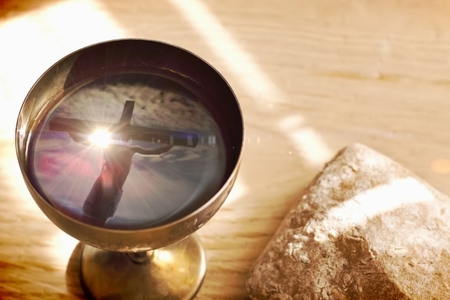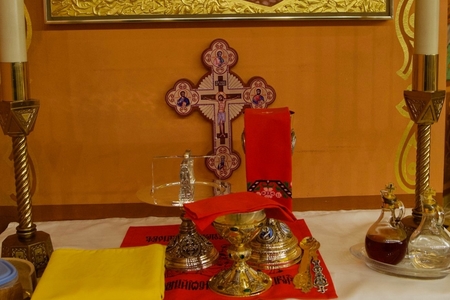"I am the bread of life; whoever comes to me will never hunger, and whoever believes in me will never thirst" - John 6:34

The celebration of the Holy Eucharist, which is known as the Divine Liturgy, is the central and most important worship experience of the Church. Often referred to as the "Sacrament of Sacraments", it is the Church's celebration of the Death and Resurrection of Christ offered every Sunday and Holy day. All the other Sacraments of the Church lead toward and flow from the Eucharist, which is at the center of the life of the Church.
In fact, attending Mass is an obligation, under penalty of mortal sin, each Sunday and on certain other Holy Days of Obligation. Similar to the Roman Catholic’s structure of the Liturgy of the Word and Eucharist, the Divine Liturgy begins with readings from Scripture and is followed by the consecration of the Eucharist. The first part of Divine Liturgy is the Liturgy of the Catechumens which includes several litanies, the propers of the day, the reading of the epistle, and a reading from one of the four Gospels.
The center of the Divine Liturgy is its second part, the Liturgy of the Faithful. In the early church, partly to protect against Christian persecution, only baptized members of the Church could stay for this part of Liturgy. Even today, we hear the deacon or priest say, “The doors, the doors, let us be attentive!” as the Liturgy of the Faithful begins. Church members would at this point close the doors, and the unbaptized would leave. During this time, Catholics receive the body and blood of Jesus Christ under the form of the bread and wine. According to the Bible, this is done in remembrance of Christ (1 Corinthians 11:23-25; cf. Luke 22:18-20 and Matthew 26:26-28).

| Saturday | 3:30 PM (Vespers) - Winter Time 4:00 PM (Liturgy) - Winter Time 4:00 PM (Vespers) - Summer Time 4:30 PM (Liturgy) - Summer Time |
| Sunday | 8:00 AM 10:00 AM |
| Holy Days of Obligations and Weekdays | Will be announced on website and in the bulletin. Click here to find recent copies of the bulletin. - Christmas Services - Easter Services |
Some Divine Liturgies are available online on our Facebook page.
The liturgical calendar refers to the cycle of seasons in the Christian church. The liturgical calendar determines when feast days and holy days are observed throughout the year. In the Eastern rite, the Liturgical year begins on September 1st, making the first great feast the Nativity of the Theotokos, the Mother of God on September 8. The last major feast of the year fittingly commeorates her passing into eternal life, the Dormition of the Theotokos, on August 15.
Of all the feasts of the liturgical year, the greatest is undoubtedly Pascha, or Easter; it is sometimes called the "feast of feasts." Of the remaining feasts the year, the Byzantine tradition chooses twelve "great feasts" as being the most important for our salvation; these are often commemorated in a special row of icons in the iconostasis in each church.
Here are the twelve great feasts, in their approximate order, beginning in September with the start of the liturgical year:

| September 8 | The Nativity (birth) of the Theotokos, the Mother of God |
| September 14 | The Exaltation of the Holy Cross |
| November 21 | The Entry of the Theotokos into the Temple |
| December 25 | The Nativity of our Lord (Christmas) |
| January 6 | The Baptism of the Lord (Theophany) |
| February 2 | The Meeting of our Lord with Simeon and Anna |
| March 25 | The Annunciation of the Angel Gabriel to the Theotokos |
| (7 days before Pascha) | Palm Sunday, the Entrance of the Lord into Jerusalem |
| (40 days after Pascha) | The Ascension of the Lord |
| (50 days after Pascha) | Pentecost, the Descent of the Holy Spirit |
| August 6 | The Transfiguration of the Lord |
| August 15 | The Dormition (death) of the Theotokos |